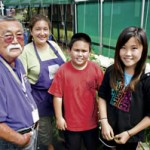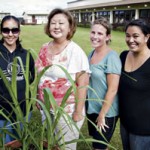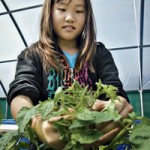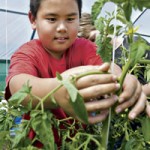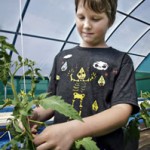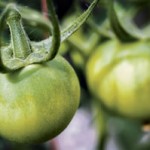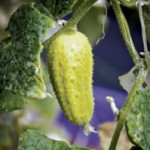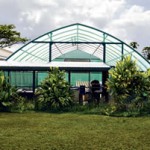Wilcox Students Learning To Grow
“Lettuce tastes better when you’ve grown it,” says fifth-grader Raine Servantes. He and I are in the new greenhouse at Wilcox Elementary School in Lihu’e, and he’s telling me that, along with the tomatoes and cucumber they have grown, lettuce is his favorite. “Because you put a lot of hard work into it.”
The greenhouse has two long tables filled with rows of plastic trays dotted with empty holes. Each hole once held a head of lettuce, and has since been wiped clean. In late February, when Kaua’i’s gardens were drenched in rain, the students harvested 1,800 heads, and delivered them to the mayor’s office, Mark’s Place, Gaylord’s, the Salvation Army and Kaua’i Independent Food Bank.
In 1998, principal Ernest Dela Cruz commissioned the building of the original greenhouse, and asked Yoshi Yuki Nakao to run the Hydroponics Program. Mr. Yoshi, as the students call him, was a custodian at Wilcox and had just retired. He accepted the post and has been volunteering ever since.
As we stand in the orderly 30-by-70-foot space, a pale-yellow light filters through a polyfilm top that allows 80 percent transmission of the sun. Opposite the lettuce trays are two equally long rows of tomato plants. Yoshi patiently teaches Raine and Jenna Takata, also a fifth-grader, how to prune tomatoes.
“You gotta take some of these small, little side shoots down,” he says. “Oddah wise it comes a jungle, yeah?”
Without damaging the stalks that have flowers, Jenna carefully removes the shoots. “When you grow tomatoes, they taste better than when you buy them at the store,” she tells me. “It tastes fresh, and they don’t have to ship it from the Mainland.”
Natalie “Hiwahiwa” Joyce-Maeda, is a farmer, and as the school’s garden coordinator and resource teacher, facilitates a grant awarded by the State Farm Youth Advisory Committee. She designs project-based learning classes, and asks me if I’d like to see the classroom gardens.
“I sit down with a group of teachers,” she says as we walk through the courtyard of the 1,000-student school. “We come up with an objective, tie it to standards and benchmarks, I make a budget, and I purchase materials.” From there, she guides the teachers with planting, tending and harvesting. Before class, the kids go to their garden and take notes about growth, bugs and plant health.
“This is the technology generation,” she says of the students, “and I think they’re a bit afraid, and isolated in front of their computer screens. I remember playing outside, and being excited watching all the creatures on this earth. I don’t want the kids to be afraid of that.”
Preschoolers taste the food they grow in class. Sometimes just four beans are harvested, steamed and added to their saimin.
Kindergarteners are introduced to the cycles of life.
“We’re letting the beauty of the whole plant go through its cycle,” Joyce-Maeda explains, “and saving seeds.”
Last year, students picked the seeds, and this year the gardens grow lettuce from those seeds.
The second-graders grew 120 Italian plum tomatoes, and donated them to the Salvation Army. “As part of their curriculum,” Joyce-Maeda says, “they have to count all the tomatoes, and then they get a math lesson.”
Fourth-graders tend an aromatic Hawaiian garden full of plumeria, ti and taro. And third-grade gardens are woven into required plantation and diversity classes. Students learn plant and ethnic diversity by growing Korean, Okinawan, Chinese, Japanese, Filipino and Puerto Rican vegetables.
“At the end of the year we’re going to have a culture fair,” says third-grade teacher Irene Isonaga, whose class tends the Japanese garden. “It’s a celebration of the plantation days.”
“In plantation times, everybody had their camp gardens,” adds Joyce-Maeda. “It’s only been one generation and – boom! – the information’s gone.
“My mission is to connect students with the earth. I don’t want them to be afraid. I don’t want them to be afraid of dirt, or worms, or creatures, or dirt on their lettuce. I don’t want them to be disconnected from their own planet.”
Colleen Carroll, Director, Kauai School Garden Network, colleen@malamakauai.org, 828-0685, ext. 13.
- (from left) Yoshi Yuki Nakao, Natalie “Hiwahiwa” Joyce- Maeda, Raine Servantes and Jenna Takata
- Third-grade teachers (from left) Naomi Nakama, Irene Isonaga, Jessie Cates and Megan Nii
- Jenna Takata
- Raine Servantes
- Chandler Martinay. Daniel Lane photos
- Second-graders’ tomatoes
- Preschoolers’ cucumber
- Wilcox Elementary Hydroponics Club
- The new greenhouse at Wilcox Elementary School. Daniel Lane photos
- The Chinese Garden grows bok choy, long beans and daikon

